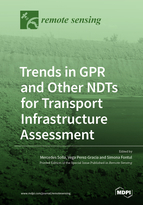Trends in GPR and Other NDTs for Transport Infrastructure Assessment
A special issue of Remote Sensing (ISSN 2072-4292). This special issue belongs to the section "Engineering Remote Sensing".
Deadline for manuscript submissions: closed (30 April 2021) | Viewed by 55742
Special Issue Editors
Interests: ground penetrating radar; signal processing; numerical modeling; civil and environmental engineering; cultural heritage; archaeology; geographic information systems (GIS)
Special Issues, Collections and Topics in MDPI journals
Interests: ground-penmetrating radar; applied geophysics; geophysical prospection; civil engineering assessment; archaeology; cultural heritage; buildings; signal processing; surveys in agriculture
Special Issues, Collections and Topics in MDPI journals
Interests: ground-penetrating radar; signal processing; road and airfield pavements; railways; condition assessment; structural characterization; transport infrastructure rehabilitation
Special Issues, Collections and Topics in MDPI journals
Special Issue Information
Dear Colleagues,
This Special Issue is mainly dedicated to publishing high-quality original research articles, reviews, and applications on the use of GPR and other NDT methods for the assessment of transport infrastructure.
Advances in different nondestructive techniques have shown their great utility in the study of infrastructures, both to make decisions about their maintenance and to control their state during the service life of each structure. Particularly, the application of ground-penetrating radar (GPR) for the evaluation and monitoring of transport infrastructure is an effective method of obtaining information about structures in a non-invasive and nondestructive way. The application of GPR, and complementary nondestructive (NDT) techniques such as ERT, seismic, pulse–echo, magnetics, thermography, etc., provides useful and accurate information about the inner state of structures and infrastructure, which offers valuable information to engineers focused on their diagnosis and maintenance. Applications are highly useful in the case of road and airfield pavements, including layer thickness assessment, compaction analysis, identification of cracking, and moisture content estimation. There is also relevant interest in railway maintenance, including the assessment of ballast thickness, as well as the estimation of fouling and moisture content. Regarding structures, the main objectives reside in the inspection of bridges and tunnels. With respect to bridges, both concrete and masonry, the most interesting aspects to investigate are rebar and tendon ducts mapping, as well as corrosion in reinforced concrete. When dealing with the inspection of masonry bridges, the interest resides in mapping different filling, estimation of moisture content, identification of voids or lack of ashlar, and measuring ring stone thicknesses. In the case of tunnels, the main applications are the estimation of lining thickness and backfill grouting, identification of cavities or cracking in lining, rebar localization, and corrosion and moisture content evaluation.
During the last few decades, there have been major advances in the development of new techniques, data analysis, and decision-making procedures. Recent trends also show an increasing interest in the combination of NDT methods for high-resolution diagnosis. However, the development of these techniques and inspection procedures needs a comprehensive and up-to-date overview of the state-of-the-art of research activities aiming to define capabilities and limitations.
We would like to invite you to submit articles on but not limited to the following topics:
- Novel developments on GPR systems and antennas;
- Novel applications and developments of NDT methods in transport infrastructure assessment;
- Advances on data acquisition methodologies;
- New data processing algorithms and GPR imaging;
- GPR procedures for transport infrastructure assessment (road and airfield pavements, railways, bridges, tunnels, etc.);
- Combined use of GPR and complementary NDT (pulse–echo, seismic, thermography, etc.) for transport infrastructure assessment;
- Geophysical assessment as support for maintenance decision and transport infrastructure management;
- Practical applications and examples illustrating the potential of NDT techniques in the study of structures and infrastructure;
- NDT applications from aerial platforms (airplanes, helicopters, drones, etc.);
- NDT computational modelling and inversion models.
Dr. Mercedes Solla Carracelas
Dr. Vega Pérez-Gracia
Dr. Simona Fontul
Guest Editors
Manuscript Submission Information
Manuscripts should be submitted online at www.mdpi.com by registering and logging in to this website. Once you are registered, click here to go to the submission form. Manuscripts can be submitted until the deadline. All submissions that pass pre-check are peer-reviewed. Accepted papers will be published continuously in the journal (as soon as accepted) and will be listed together on the special issue website. Research articles, review articles as well as short communications are invited. For planned papers, a title and short abstract (about 100 words) can be sent to the Editorial Office for announcement on this website.
Submitted manuscripts should not have been published previously, nor be under consideration for publication elsewhere (except conference proceedings papers). All manuscripts are thoroughly refereed through a single-blind peer-review process. A guide for authors and other relevant information for submission of manuscripts is available on the Instructions for Authors page. Remote Sensing is an international peer-reviewed open access semimonthly journal published by MDPI.
Please visit the Instructions for Authors page before submitting a manuscript. The Article Processing Charge (APC) for publication in this open access journal is 2700 CHF (Swiss Francs). Submitted papers should be well formatted and use good English. Authors may use MDPI's English editing service prior to publication or during author revisions.
Keywords
- GPR
- NDT
- Civil Engineering
- transport infrastructure
- roads
- airfields
- railways
- structures
- signal processing
- antennas and radar systems








